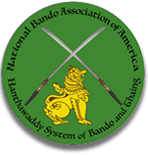The American Bando Association is a non-profit organization dedicated to honoring American Veterans and to the preservation of the Hanthawaddy Bando martial arts that originated in Burma (known today as Myanmar).
The ABA does not condone war, but pays special tribute to those who fought for freedom. For the last 50+ years, members of ABA have made special efforts to recognize and honor all servicemen and women on Memorial Day [May], Veterans Day [November] and VJ Day [August].
Nature of Systems:
No system is completely unique.
No system is completely independent from
external and internal influences.
Every system is the result of change.
Every system evolves over time by integration,
modification and restructuring,
resulting in what we then call “uniqueness”
Overtime, this unique system will also change.
{His Holiness the Venerable Amarapura Sayadaw, 1910}
 During WWII, Burma became a major battlefield between the Imperial Japanese forces and the Allied forces {Great Britain, USA, China and India}. Japanese military ambition was to conquer India and China by using Burma as their military base for attack and also blocking all assistance to China. The countries involved in this theatre were the British, Americans, Chinese, Indians, Gurkhas, West Africans, Japanese, Koreans, Okinawans and Manchurians. There were also Burmese, Kachins, Chins, Shans, Mons, Arakanese, and other tribesman. Many battles fought in both northern and southern Burma involved jungle warfare and close-quarter hand-to-hand fighting. Burma became the testing ground for many of the combative arts of the Indians, Kachins, Karens and other tribes. There was active exchange of martial techniques at various training camps and among various troops and tribes. It was noted that the Japanese suffered their largest land defeat during WWII in Burma.
During WWII, Burma became a major battlefield between the Imperial Japanese forces and the Allied forces {Great Britain, USA, China and India}. Japanese military ambition was to conquer India and China by using Burma as their military base for attack and also blocking all assistance to China. The countries involved in this theatre were the British, Americans, Chinese, Indians, Gurkhas, West Africans, Japanese, Koreans, Okinawans and Manchurians. There were also Burmese, Kachins, Chins, Shans, Mons, Arakanese, and other tribesman. Many battles fought in both northern and southern Burma involved jungle warfare and close-quarter hand-to-hand fighting. Burma became the testing ground for many of the combative arts of the Indians, Kachins, Karens and other tribes. There was active exchange of martial techniques at various training camps and among various troops and tribes. It was noted that the Japanese suffered their largest land defeat during WWII in Burma.
After WWII, ex-servicemen introduced many Asian martial arts systems to the United States from the US Army, Navy, Air Force and Marines. Thousands of Americans served in the China-Burma-India Theater of the Pacific Theatre of WWII. Mahasayaji Gyi felt that the Americans and the Allied Forces, who had fought and died in the Burma Campaign against the Imperial Japanese Army, should be remembered and honored.
Therefore, in 1967, Dr. Gyi established the American Bando Association [ABA] as a private, non-profit martial arts organization for the purpose of:
- Honoring the veterans of China Burma India Theater of WWII.
- Preserving the combative arts practiced in the CBI Theater during WWII.
- Promoting cross-cultural exchange of martial arts and martial sports in the USA.
 The American Bando system as practiced in the United States is influenced by the systems of many countries including 1] WW II combative techniques of the 10th Burma Rifles, 2] Japanese systems taught in Burma during their occupation, 3] ancient Chinese systems, 4] ancient Indian systems 5] ancient Tibetan systems, 6] ancient Mongolian systems, 7] both ancient and modern martial systems of Thailand, 8] American and western systems of boxing, and many others.
The American Bando system as practiced in the United States is influenced by the systems of many countries including 1] WW II combative techniques of the 10th Burma Rifles, 2] Japanese systems taught in Burma during their occupation, 3] ancient Chinese systems, 4] ancient Indian systems 5] ancient Tibetan systems, 6] ancient Mongolian systems, 7] both ancient and modern martial systems of Thailand, 8] American and western systems of boxing, and many others.
The American Bando Association [ABA] was the American Branch of the National Bando Association [NBA], which was formed in Burma in 1946 by a group of retired military officers.
During the past half-century, Mahasayaji (grandmaster) Dr. M. Gyi has translated numerous old documents from his father, U Ba Than Gyi, and many other elders and masters of Burma. Through translating these documents, Mahasayaji Dr. M. Gyi has added to the original curriculum that was first established back in 1966 and raised up a cadre of senior students who are now Masters in their own right. Mahasayaji Gyi also knew that for the American Bando Association to survive and thrive, numerous changes, adaptations and adjustments had to be made. Any system, which is not willing to change and improve, becomes obsolete and cannot survive in the highly competitive American society. Old Bando systems, which were considered obsolete, had to be upgraded, reformed and restructured.
Through the past 30 years there have been many changes and improvements to the ABA. In 2006, Mahasayaji Gyi appointed 9 animal masters in charge of carrying on the 9 unique Bando Animal Systems by teaching and overseeing the training specific to each animal. In 2009, Mahasayaji Gyi appointed directors to the 7 various divisions within the ABA. Those divisions include the Bando Animal Systems, the Bando Kickboxing System, the Bando Free-Fighting System, the Bando Weapons Systems, the Bando Naban (grappling) System, the Bando Monk System and the Bando Yoga Systems. These directors are charged with overseeing the instruction advancement of skills and levels of certification [student, instructor, master] in their respective divisions. A typical student is usually exposed to all facets of instruction in the ABA although many schools specialize in only one or two areas of focus. The Bando system today is extensive and diverse with areas of focus that range from the combative harming in the kickboxing systems to harmonizing and healing of the Monk and Yoga systems.
The ABA holds three major annual events upholding their mission of honoring veterans of China-Burma-India Theatre of WWII, the Korean War and the Vietnam War. These events are held annually on:
- Memorial Day in May
- V-J Day in August
- Veterans Day in November
Contributions of Bando to the Community of Martial Arts in the United States
- ABA is the only non-profit War Memorial Martial Arts Organization honoring America’s veterans of WWII, the Korean War and the Vietnam War.
- ABA is one of the longest existing martial arts organizations, with more than 50 years of uninterrupted and continuous history.
- ABA is the first Martial Arts organizations, which introduced a combative system from Burma to United States. A decade or more later other martial systems from Southeast Asia (the Philippines, Thailand, Indonesia and Malaysia) were introduced to America.
- ABA, coordinating with the officials of the Black Belt Magazine and leaders of various karate systems, was partly responsible for the establishment of tournament rules and regulations for open tournaments in the United States.
- ABA Introduced the wearing of Black karate uniforms in open tournaments which was later adopted by other karate systems
- ABA was partly responsibly for establishing rules and regulations for regional and national championship tournaments of the United States Karate Association [USKA]
- ABA is the founder of amateur kick-boxing in the USA, with the longest running competition of over 40 years of continuous events held in America.
- ABA was partly responsible for the development of the full-contact Professional Karate Association [PKA] in the United States and later the rest of the world.
- ABA is the founder of continuous free fighting and round-robin matches in the United States, which were later adopted by other systems in open and invitational tournaments.


